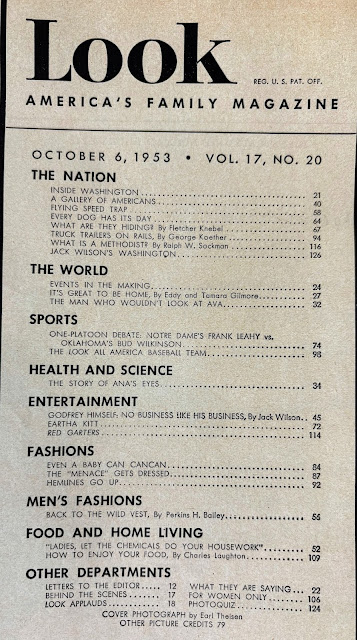Here we have another discovery that popped up recently as my brother Richard and I continued our journey through all the family materials at mom's house in Huntsville. Of course, what caught my attention first about this October 6, 1953 Look magazine was actress Ava Gardner on the cover. Duh. But as I examined the issue, I also found a long article on Alabama native Eddy Gilmore and his Russian ballerina wife Tamara. You just never know what will turn up where. I'd read a bit about Gilmore in the past, so I decided to do this blog post and explore his life and career some more.
Eddy Lanier King Gilmore was born in Selma on May 28, 1907. I found little about his family via Ancestry.com. His father was Edwin Lanier Gilmore and mother Evelyn B. "Emely" King Gilmore. That at least explains his two middle names. I did find Edwin's World War I draft registration card, which listed him as a traveling salesman for the C.W. Cooper Company, wholesale grocers. Indicative of his future profession was Eddy's job as a young boy--delivering newspapers for the Selma Times-Journal.
Gilmore graduated in 1928 from Carnegie Tech in Pittsburgh, founded by Andrew Carnegie and now Carnegie Mellon University. He worked at the Atlanta Journal until 1932 and then the Washington Daily News until the Associated Press hired him sometime before 1940. Soon the AP sent him to the Soviet Union as bureau chief where he lived until 1953. Thus he covered the Eastern Front of World War II as the Soviets battled Nazi Germany.
During his time in the country he interviewed Joseph Stalin; that piece won him the 1947 Pulitzer Price for Telegraphic Reporting-International. Gilmore spent most of the rest of his life working for the AP in London, He died there of a heart attack at his East Grinstead country home after a day at work on October 6, 1967. Several people who knew him noted that he never lost his Southern accent.
While living in the Soviet Union Gilmore met and fell in love with Tamara Kolb Chernashova, a ballerina with the Bolshoi Ballet. Soviet citizens were not supposed to fraternize with foreigners, but their relationship persisted despite government refusals to let them marry. They were finally able to wed in 1950, but unable to leave the country until after Stalin's death in 1953. The couple would have three daughters and a son. After leaving the Soviet Union Gilmore often wrote about the royals of Europe he met, both their glamour and the reality.
The Look magazine article features Eddy and Tamara describing life in the Soviet Union--the prices of foods and clothing, the salaries earned by different workers, etc. A pair of quotes from Tamara struck me.
"I am a Russian, sometimes happy, sometimes sad. It is a big and strange and mysterious country, even to Russians, but it is our land. It's not for me to criticize."
"When we came away, it was first Stockholm, and then Paris and then New York and then Alabama. They are nice, these places. I would like to go again to Paris."
I don't know about Tamara visiting Alabama again, but Eddy's body was returned to Selma for a funeral service and burial. See below for more images and information.
In 1968 Tamara published Me and My American Husband. She remained in London until her death on April 15, 1980; she was 52, 20 years younger than Eddy.
A 2014 article about "Selma's forgotten Pulitzer Prize-winner" can be read here and the Associated Press' obituary here. Some of his papers are held by Syracuse University.











































